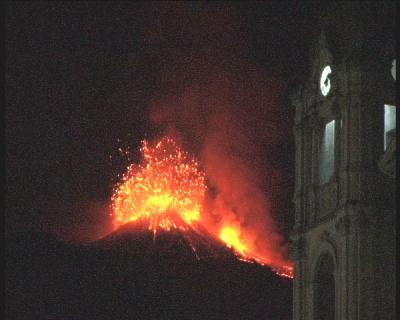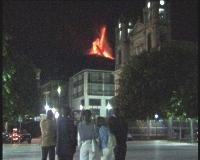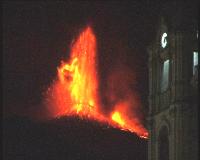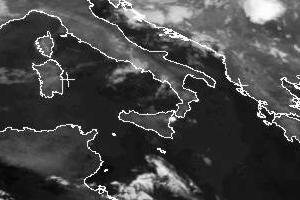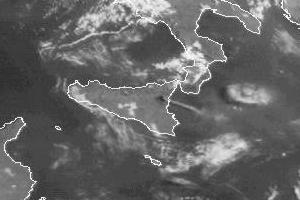|
Do
you plan to visit Etna in the near future? NEW:
Excursions to the Etna area, The Etna telecamera is maintained by the "Sistema Poseidon" and there is no relationship of any kind with this site and its author. The Poseidon web site is in Italian, and the link to the telecamera is changed frequently, so that it is not indicated here (click on "Etna live cam" on the Poseidon home page). Please note also that all information provided on the present page (and the archived Etna news pages) is informal, based on personal observations, and is not intended to substitute, or compete with, the news bulletins now issued regularly at the Poseidon web site.
29 May 2000 update. Etna has returned to a state of relative calm after the latest paroxysmal eruptive episode from the SE Crater of late 27 May (the paroxysm culminated at around 2300 h, not before 2200 h as reported previously). Ash emission from the NE Crater continued during the morning of 28 May but then gradually diminished. Light ash falls caused by this activity occurred to the S and SSE of Etna, extending to the outskirts of Catania. However, much more significant tephra falls occurred after the SE Crater paroxysm of late 27 May to the SW of the volcano (as suspected in the previous update of 28 May), hitting mostly the town of Adrano. This area had so far received only little tephra from the eruptive activity at the SE Crater initiated on 26 January. 28 May 2000 update.
A new eruptive episode - the 58th in 4 months and 1 day - occurred
during the evening of 27 May at the SE Crater. This event, which came
after a quiet interval of more than 4.5 days, could not be well observed
due to cloud cover; however, the approximate timing and some details
of the extent of lava flows could be established due to the faithful
"volcano watch" from Acireale by Giuseppe Scarpinati (Italian
delegate of the French "Association Volcanologique Européenne").
23 May 2000 update.
The SE Crater reactivated on the evening of 22 May with the slow emission
of small lava flows from the fissure on the N flank of its cone. This
activity culminated at dawn the next morning with the 57th paroxysmal
eruptive episode in 4 months. Observations of the activity were made
until 0100 h on 23 May by Boris Behncke (Dipartimento di Scienze Geologiche,
University of Catania) from Fornazzo, on the E flank of Etna, and
thereafter by Giuseppe Scarpinati (Italian delegate of the French
Association Volcanologique Européenne) from Monte Zoccoloaro,
on the SE flank of Etna.
For the
next two hours the activity continued at the same painfully slow pace
as previously. At about 0300 h when Scarpinati had begun to feel the
strong desire to return to his home in Acireale, lava spattering began
at the N flank vents. This activity continued for about 15 minutes
and then decreased notably, only to increase once more shortly thereafter.
During the following 100 minutes the activity underwent repeated fluctuations,
and only at 0450 h, a low but steady lava fountain began to rise from
the vent area on the N flank of the SE Crater cone. Five minutes later
the fountain rose 30 to 40 m high, and the output of lava increased
dramatically. At 0505 h the summit vent of the SE Crater, which until
then had shown no signs of activity, began to emit large volumes of
ash, forming a plume that rapidly rose high above the cone. Two minutes
later a huge jet of lava rose from the same vent, thus initiating
the phase of lava fountaining, which continued for about 25 minutes.
The radiating heat of the fountain could be clearly felt by Scarpinati
at his observation site about 6.5 km from the erupting vent. Large
amounts of tephra were produced with the fountain, which rose in an
eruption column several kilometers high. A heavy downpour of lapilli
occurred on the ENE flank of Etna, depositing several centimeters
of scoriaceous clasts on the "Mareneve" road which connects
the Rifugio Citelli with Fornazzo. Some of the clasts were up to 5
cm in diameter. Lapilli also fell in Fornazzo, Sant'Alfio, Mascali,
Giarre, and Fiumefreddo.
The activity
at the summit vent of the SE Crater ended abruptly at 0535 h, but
lava spattering continued for about 10 minutes at the N flank vents
before all activity subsided. Lava flowed mainly from the N flank
fissure to the NE and E, but a small lava flow was also formed on
the S side of the cone, although there were apparently no vents on
that flank of the cone. Several other web pages covering the recent and ongoing eruptions of the Southeast Crater are now available; these contain photos and movie clips of some of the most spectacular moments of that period. Etna in 2000 - a list of all paroxysms at the SE Crater since 26 January and photos (this site) Extremely
spectacular video clips, taken by British cameraman and film maker
David Bryant on 15 February 2000 An interview with Boris Behncke, made in late February 2000 by a BBC team and a video clip (RealPlayer) Photos of the eruptive activity, 15-23 February 2000, by Tom Pfeiffer (University of Arhus, Denmark) Photos of the 15 February 2000 paroxysm of the SE Crater, by Thorsten Boeckel, Germany Photos by Marco Fulle, 15-20 February 2000, at Stromboli On-line - very high quality, as usual |
||||||||||||||||||||||||||||||||||||
|
Copyright
© Boris Behncke, "Italy's Volcanoes: The Cradle of Volcanology"
|
|||||||||||||||||||||||||||||||||||||
|
Page set up on 27 May 1997, last modified on 29 May 2000 |
|||||||||||||||||||||||||||||||||||||

